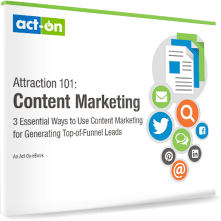I’m often asked, “Should I use an inbound or an outbound strategy?” Inside my own head I always have the same response: “Seriously?! What kind of question is that?”
question is that?”
This is then followed by the more rational complete response of, “If the goal is to attract the largest audience to your message, why not both?”
The BigBlog Advocate will tell you to go Inbound. To disarm the outbound argument they will tell you that buying a list and sending email to it is illegal. Then they will point you to a link saying, “Well, sort of. If you do it illegally its illegal, but you can totally do it legally, but you shouldn’t cause the boogeyman will get you.”
The EmailEveryone Advocate will tell you to go Outbound. To disarm the Inbound argument they will tell you to be aggressive and start sending email; then money will rain from the sky. Then you’ll go through training and they’ll say, “Well, sort of. If you Spam everyone you’ll get blacklisted and never get another email through ever.”
You see, this isn’t a 1950’s sci-fi flick where the good guys wear white and the bad guys wear black. It’s the 21st Century, the space is crowded and noisy, and whoever has the most effective marketing wins. No single tactic is the trump card. No one product is the clear winner – otherwise there would only be one product.
Here are 5 key points to developing a comprehensive digital campaign using Inbound AND Outbound marketing tactics:
1. Understand your audience, including THEIR Buyer’s Journey
Most marketing departments have figured out that their content needs to be “buyer oriented.” We’ve mastered the skill of pitching value, ROI, and benefits for the customer. This method is excellent, for the BOTTOM of the funnel.
However – for true top of funnel content, the buyer has not even begun to consider what options are available, much less which option is best for her. The key to effective “Attract” campaigns is to forget your value positioning. At the true Top of the funnel, the Buyer is only aware that they are uncomfortable, in pain, or disrupted.
Consider this idea – All humans go through a process when they make a decision – ANY decision. It looks like this:
2. Categorize your marketing funnel by the Buyer’s Journey
So what does this mean for marketers? It means that if we understand the journey our buyer is on, we can tailor our message to our audience based on the needs and criteria of the stage they are in. So in understanding our buyer’s journey, we gain the framework for our marketing funnel a seen here:
3. Create “funnel appropriate” content
 Now that we have a framework in place, we head back to the white board.
Now that we have a framework in place, we head back to the white board.
In the Top of Funnel content, we ask “What causes someone who will buy my product to need my product?” In Middle of Funnel content, we ask “What does someone who needs my product need to know about my product?”. In Bottom of Funnel content we ask, “Why would they choose my product over their other options.”
Answering these questions will give you the topics needed for truly engaging messaging at every stage.
4. Leverage appropriate media
Every content message can be used in multiple media assets. A great LinkedIn article, for example, would also likely be a good blog post, whitepaper, and landing page. Media is the container in which we put our content, and broadening the number of potential touch points is key to Attracting, Capturing, and Nurturing an engaged audience.
5. Distribute on “funnel appropriate” channels
Inbound marketing or outbound? Nope – Destination Bound. We distribute content to Facebook, Twitter, LinkedIn, our website, and our blog, and launch banners ads, retargeting campaigns, emails, trade shows, phone calls, and text messages. (Inbound and outbound)
You see, if our content is right, it’s not a decision about Inbound or Outbound. No one channel will reach our entire potential audience, ever. The key is to make sure that our funnel appropriate content is launched via funnel appropriate channels. An email to a cold list asking them to “buy” something is a quick way to the spam folder, and a social media or blog post with a demo invite is a great way to get ignored. Top of funnel blog posts are the wrong place for closing messages, and bottom of funnel emails are the wrong place for “10 Quick Tips”.
All marketing efforts are about getting the right message, to the right person, at the right time, so be selective and deliberate about how you deliver your carefully crafted message.
BOOM! Real digital marketing done right. No more Inbound vs Outbound BS – Just effective results, sales pipeline, and probably a pay raise.
Good luck!
Feel free to reach out with any questions and leave your comments below!
Looking for more tips on how you can create that’s relevant for the different funnel stages of your buyer’s journey? Check out our free workbook, 4 Steps to Develop a Content Plan, and get the resources you need to serve up content that will help your buyers at each stage of their journey.


